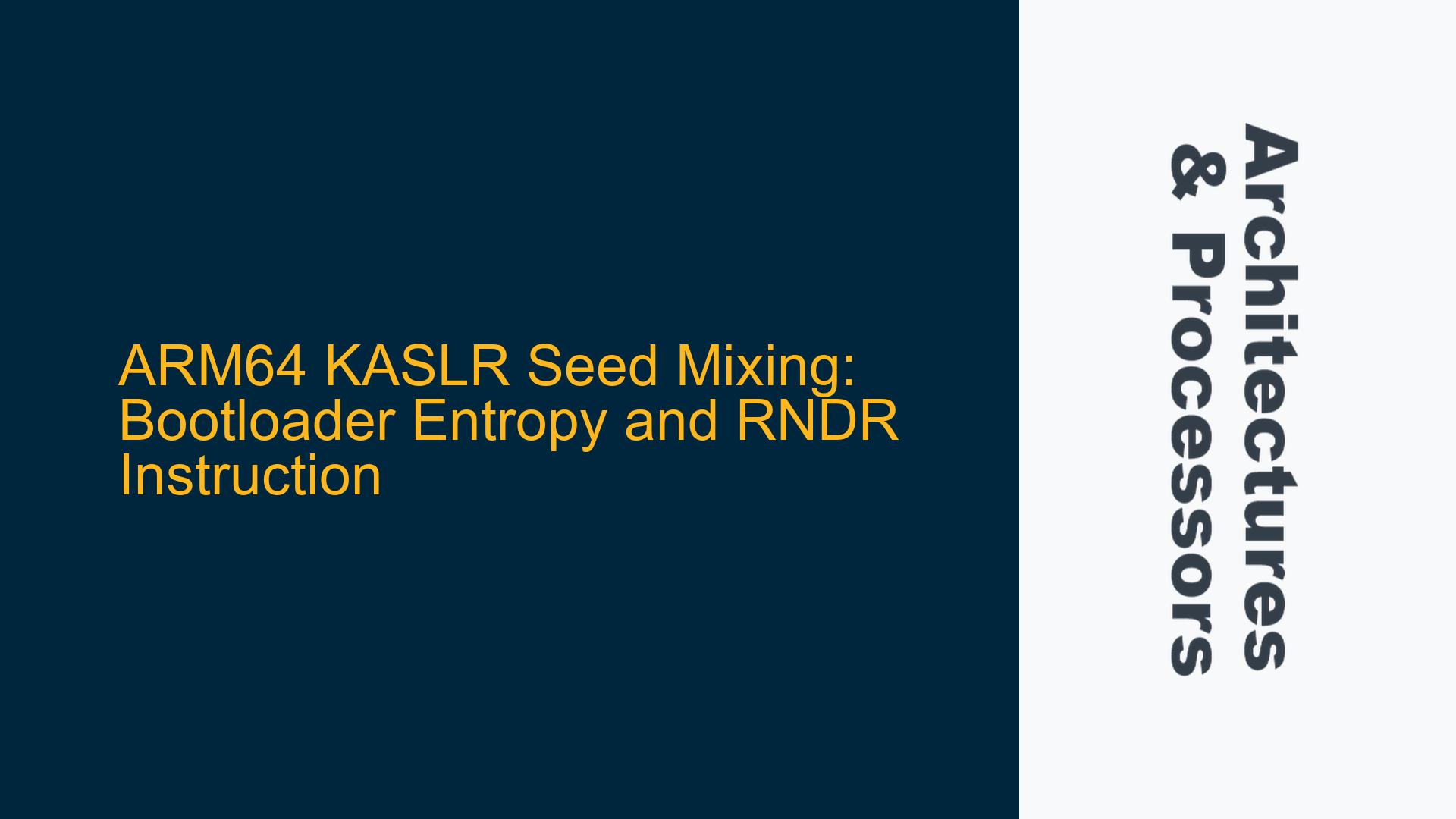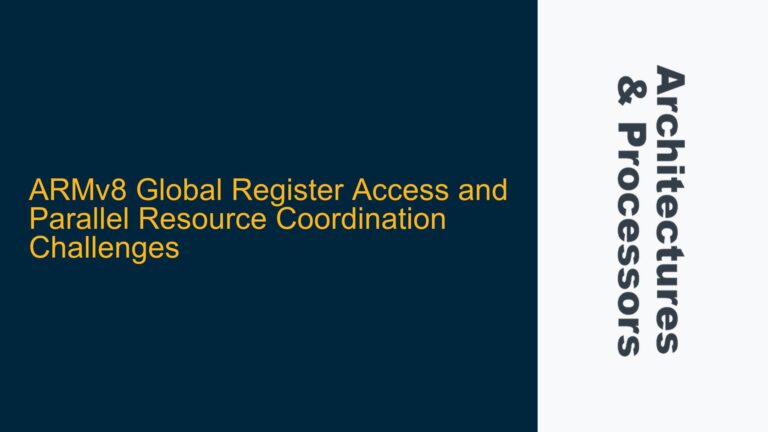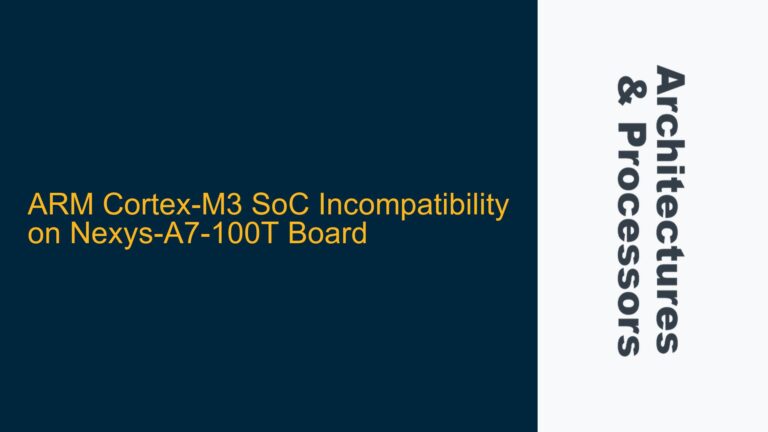ARM64 KASLR Seed Generation with Bootloader Entropy and RNDR Instruction
The ARM64 architecture employs Kernel Address Space Layout Randomization (KASLR) as a security mechanism to randomize the kernel’s base address at boot time. This randomization makes it significantly harder for attackers to predict the location of critical kernel structures, thereby mitigating certain types of exploits. The KASLR seed, which determines the randomization offset, is derived from multiple sources of entropy. One of the key sources is the bootloader’s entropy, which is combined with the output of the ARMv8.5 Random Number Generator (RNDR) instruction. This combination raises questions about why multiple entropy sources are necessary and how they interact to enhance security.
The bootloader’s entropy is typically derived from hardware-specific sources such as the system’s clock, device-specific registers, or other platform-specific mechanisms. This entropy is passed to the kernel via the Flattened Device Tree (FDT) or other boot-time data structures. However, relying solely on bootloader entropy can be risky, as the quality and randomness of this entropy may vary depending on the platform and bootloader implementation. Additionally, if an attacker can predict or manipulate the bootloader’s entropy, the effectiveness of KASLR is compromised.
To address these concerns, the ARM64 Linux kernel incorporates additional entropy from the RNDR instruction, which is part of the ARMv8.5 architecture’s Random Number Generator extensions. The RNDR instruction provides a cryptographically secure random number generated by the hardware, ensuring a high degree of randomness. By XORing the bootloader’s entropy with the output of the RNDR instruction, the kernel creates a more robust and unpredictable KASLR seed. This approach leverages the strengths of both entropy sources: the bootloader’s entropy provides platform-specific randomness, while the RNDR instruction ensures cryptographic security.
The combination of these entropy sources is particularly important in scenarios where the bootloader’s entropy may be insufficient or compromised. For example, in embedded systems with limited hardware randomness sources, the bootloader’s entropy might be predictable or repeatable across reboots. By mixing in the RNDR output, the kernel ensures that even if the bootloader’s entropy is weak, the final KASLR seed remains secure. This dual-source approach aligns with security best practices, which recommend using multiple independent sources of entropy to enhance the overall security of cryptographic systems.
Bootloader Entropy Limitations and RNDR Instruction Benefits
The use of bootloader entropy in KASLR seed generation introduces several potential limitations that necessitate the inclusion of additional entropy sources like the RNDR instruction. Bootloader entropy is often derived from hardware-specific sources, which may not always provide sufficient randomness. For instance, on systems with limited hardware capabilities, the bootloader might rely on simple counters or timers, which can be predictable or repeatable across reboots. This predictability undermines the effectiveness of KASLR, as an attacker could potentially guess or brute-force the kernel’s base address.
Moreover, the bootloader’s entropy generation process may be vulnerable to manipulation or observation by an attacker. If an attacker can influence the bootloader’s execution environment, they might be able to control or predict the entropy values passed to the kernel. This scenario is particularly concerning in secure boot environments, where the bootloader is a critical component of the system’s trust chain. By introducing additional entropy from the RNDR instruction, the kernel mitigates these risks by ensuring that the final KASLR seed is not solely dependent on the bootloader’s entropy.
The RNDR instruction, introduced in the ARMv8.5 architecture, provides a hardware-based random number generator that is designed to meet cryptographic security standards. Unlike software-based random number generators, which may rely on deterministic algorithms or external entropy sources, the RNDR instruction leverages the underlying hardware’s physical randomness properties. This hardware-based approach ensures that the generated random numbers are both unpredictable and resistant to tampering. By incorporating the RNDR output into the KASLR seed, the kernel adds a layer of cryptographic security that complements the bootloader’s entropy.
Another advantage of the RNDR instruction is its availability early in the boot process. The ARM64 Linux kernel’s kaslr_early_init function, which generates the KASLR seed, is executed during the early stages of kernel initialization. At this point, the kernel may not have access to other entropy sources, such as the system’s entropy pool or external hardware devices. The RNDR instruction provides a reliable source of randomness that can be used immediately, ensuring that the KASLR seed is generated as early as possible. This early availability is crucial for maintaining the security of the kernel’s address space layout throughout the boot process.
Implementing KASLR Seed Mixing with Bootloader Entropy and RNDR Output
The implementation of KASLR seed mixing in the ARM64 Linux kernel involves several key steps to ensure that the final seed is both secure and unpredictable. The process begins with the retrieval of the bootloader’s entropy from the Flattened Device Tree (FDT). This entropy is typically stored in a specific node of the FDT, which the kernel accesses using the get_kaslr_seed function. Once retrieved, the bootloader’s entropy is combined with the output of the RNDR instruction using a bitwise XOR operation. This operation ensures that the final seed incorporates randomness from both sources, making it more resistant to prediction or manipulation.
The arch_get_random_seed_long_early function is responsible for invoking the RNDR instruction and retrieving its output. This function is designed to be called during the early stages of kernel initialization, when other entropy sources may not yet be available. The function checks whether the RNDR instruction is supported by the hardware and, if so, executes the instruction to obtain a 64-bit random value. This value is then XORed with the bootloader’s entropy to produce the final KASLR seed.
The use of XOR for combining the entropy sources is a deliberate choice, as it ensures that the final seed retains the randomness properties of both inputs. XOR is a reversible operation, meaning that if either input is random, the output will also be random. This property is particularly important in the context of KASLR, where the goal is to maximize the unpredictability of the kernel’s base address. By XORing the bootloader’s entropy with the RNDR output, the kernel ensures that even if one source of entropy is compromised, the other source can still provide sufficient randomness.
In addition to the technical implementation, the ARM64 Linux kernel includes several safeguards to ensure the integrity of the KASLR seed generation process. For example, the kernel verifies that the bootloader’s entropy is properly wiped from memory after it is used, preventing potential leaks of sensitive information. The kernel also includes checks to ensure that the RNDR instruction is supported and functioning correctly, providing fallback mechanisms in case the instruction is unavailable or fails to produce a valid random number. These safeguards help to maintain the security and reliability of the KASLR mechanism, even in the face of potential hardware or software issues.
The combination of bootloader entropy and RNDR output in the ARM64 KASLR seed generation process represents a robust approach to enhancing kernel security. By leveraging multiple sources of entropy, the kernel ensures that the KASLR seed is both unpredictable and resistant to manipulation. This dual-source approach aligns with best practices in cryptographic security, where the use of multiple independent entropy sources is recommended to mitigate the risks associated with any single source. As ARM64 systems continue to evolve, the integration of hardware-based random number generators like the RNDR instruction will play an increasingly important role in securing the kernel and protecting against advanced threats.






